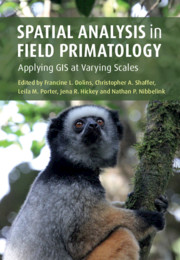Book contents
- Spatial Analysis in Field Primatology
- Spatial Analysis in Field Primatology
- Copyright page
- Dedication
- Contents
- Contributors
- Acknowledgments
- 1 Why Place Matters, and its Use in Primate Behavioral and Ecological Research
- Part I GPS for Primatologists
- Part II GIS Analysis in Fine-Scale Space
- Introduction
- 7 Home Range Analysis
- 8 Quantifying Resource Dispersion in Free-Ranging Bearded Sakis in Guyana
- 9 Interpreting Small-Scale Patterns of Ranging by Primates
- 10 Determining the Presence of Habitual Travel Route Networks in Orangutans (Pongo pygmaeus morio) in Kutai National Park, Borneo
- 11 Finding Fruit in a Tropical Rainforest
- 12 Random Walk Analyses in Primates
- 13 The Use of Small-Scale Spatial Analysis to Evaluate Primate Behavior and Welfare in Captive Settings
- 14 The Promise of Spatially Explicit Agent-Based Models for Primatology Research
- Part III GIS Analysis in Broad-Scale Space
- Index
- Plate Section (PDF Only)
- References
12 - Random Walk Analyses in Primates
from Part II - GIS Analysis in Fine-Scale Space
Published online by Cambridge University Press: 29 January 2021
- Spatial Analysis in Field Primatology
- Spatial Analysis in Field Primatology
- Copyright page
- Dedication
- Contents
- Contributors
- Acknowledgments
- 1 Why Place Matters, and its Use in Primate Behavioral and Ecological Research
- Part I GPS for Primatologists
- Part II GIS Analysis in Fine-Scale Space
- Introduction
- 7 Home Range Analysis
- 8 Quantifying Resource Dispersion in Free-Ranging Bearded Sakis in Guyana
- 9 Interpreting Small-Scale Patterns of Ranging by Primates
- 10 Determining the Presence of Habitual Travel Route Networks in Orangutans (Pongo pygmaeus morio) in Kutai National Park, Borneo
- 11 Finding Fruit in a Tropical Rainforest
- 12 Random Walk Analyses in Primates
- 13 The Use of Small-Scale Spatial Analysis to Evaluate Primate Behavior and Welfare in Captive Settings
- 14 The Promise of Spatially Explicit Agent-Based Models for Primatology Research
- Part III GIS Analysis in Broad-Scale Space
- Index
- Plate Section (PDF Only)
- References
Summary
Models of foraging behavior often assume that foragers either have no information about the spatial distribution of resources that they seek or, at the other extreme, that they are omniscient with regard to the locations of those resources. This is paralleled by a distinction between the optimization of search behavior (which assumes no knowledge of resource locations) and the pursuit of efficient routes between multiple resource patches (often explicitly considered to be a cognitive task). In this chapter we discuss a variety of movement models that have recently become common in animal ecology. We then use a population of hamadryas baboons as a case study to investigate the relevance of these models to a species possessing spatial memory and learning capabilities.
- Type
- Chapter
- Information
- Spatial Analysis in Field PrimatologyApplying GIS at Varying Scales, pp. 247 - 266Publisher: Cambridge University PressPrint publication year: 2021

